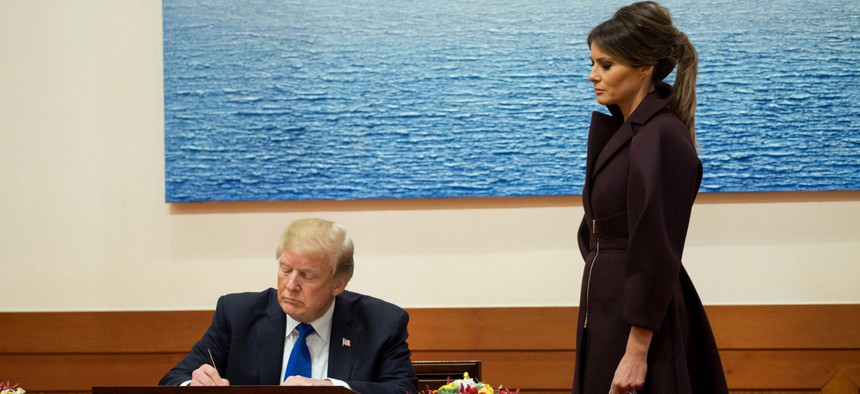
Shealah Craighead/White House
Women: Watch Out For The 'Trump Effect' In Negotiations
How to outsmart "Art of the Deal"-style tactics.
“My style of deal-making is quite simple,” wrote Donald Trump—or rather, his ghostwriter—in the 1987 book Trump: The Art of the Deal. “I aim very high, and then I just keep pushing and pushing and pushing to get what I’m after.”
The Art of the Deal is a snapshot of the aggressive, posturing, I-win-you-lose style of negotiation one associates with boardrooms in the 1980s and ‘90s. Known in business textbook-speak as distributive bargaining, this mindset assumes that resources are scarce and whatever one party gets, the other can’t have. It’s great if what you want is to walk out feeling not only that you’ve won but that you’ve crushed the other party.
It’s not so great if you want an ongoing relationship with the person or people you’re negotiating against.
An alternative model is integrative bargaining. Popularized in the 1981 book Getting to Yes and widely adopted since, this negotiation style identifies what each party actually wants, and looks for opportunities to satisfy those needs. For example, a mediator resolving a standoff between union and management might identify non-monetary benefits that are valuable to workers and allow management to stay on budget.
Negotiators in public policy, international relations, business, and law have increasingly opted for this “win-win” style in complex negotiations, says Carrie Menkel-Meadow, a law professor at the University of California Irvine and a pioneer in dispute resolution studies.
Trump’s presidency, however, may have interrupted this evolution.
Evidence for this comes from a fascinating if accidental experiment at the Wharton School at the University of Pennsylvania. In the fall 2016 semester, professor Corinne Low and doctoral student Jennie Huang were studying gender and negotiation, with an experiment in which randomly matched pairs of test subjects had to negotiate with one another to divide $20.
Initially, the researchers noticed that male players were less aggressive when they knew they were negotiating against a female opponent. (All communication between pairs was online, and not all pairs were told their partner’s gender.) But after Nov. 8, 2016, players’ behavior changed. The US election wasn’t the only highly charged event that week. As the authors noted in their paper on the study (pdf), an upsetting racist incident on the Penn campus days after the election may have affected participants as well.
Whatever the reason, communication between the randomly matched teams changed markedly. Players became more aggressive with one another—especially men who knew they were playing against a woman. The confrontational style came at a cost. Players who communicated aggressively earned $1.08 less per round on average than those who cooperated.
The researchers have not repeated the study since, so it’s not clear if this was a brief shift or the start of a long-term change in behavior. But it’s far from the only example of contagious bad behavior. Reports of bullying and hate crimes rose in the US after the election, and hate crime rates have stayed high since. Research prior to the election found that unethical behavior is contagious, and that people living in blatantly corrupt countries were more likely to follow their leaders’ example and show personal dishonesty in lab experiments.
As president, Trump has seemed to apply an Art of the Deal mentality to international diplomacy: threatening North Korea on Twitter, aggressively pushing China toward a trade war. Menkel-Meadow, the dispute resolution expert, says that this winner-take-all mindset comes at a price.
“When you ‘win’, there’s a loser on the other side, and losers want revenge,” she tells Quartz At Work. “If you know it’s a one shot deal then fine, go ‘win,’ you’ll never see the person again. But the real world consists of very few one-shot deals.”
So what is a person who wants a win-win situation to do, when confronted with a negotiating partner who wants to win at all costs? Menkel-Meadow has some suggestions for how to keep a clear head in an aggressive negotiation.
Identify what’s important
Before going into a negotiation, establish what you and the other party really want from this deal. Don’t forget to evaluate what you have that the other party wants. “Assess what the real power is in the situation,” Menkel-Meadow says. “The person may want to win, but they still need you, or else they wouldn’t be talking to you.”
Do your research
Ask questions—a lot of them. Who are you negotiating with? What have they offered others in previous deals? What is each side’s comfort with risk? What information do they have about you? “You can make up for youth, inexperience and lower power by taking the time to do your research,” says Menkel-Meadow.
Don’t be rushed or intimidated
If you feel that you’re being pressured to make a deal that doesn’t feel comfortable, stop. Ask for more time or a break until you’ve regained a sense of power. Fight back against arbitrary deadlines and don’t agree to anything if you’re feeling intimidated.
Even Trump knew this in The Art of the Deal: “The worst thing you can possibly do in a deal is seem desperate to make it. That makes the other guy smell blood, and then you’re dead. The best thing you can do,” he concludes, “is deal from strength.”






